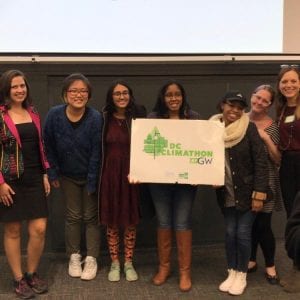Planning for Climate Change Impacts at GW
Kehan Desousa
Why is it important for GW to plan for resilience to climate change? Resilience refers to the capacity of a community, business, or natural environment to prevent, withstand, respond to, and recover from a disruption, like the impacts of climate change. We know that GW and the DMV region are already experiencing these impacts, which means we need to make sure we're resilient to them.
The District and GW have been experiencing impacts related to climate change for a number of years now, like the 2012 Derecho that flooded the Mount Vernon Campus. In fact, GW's 2017 Climathon focused on "hacking" resilience in the District. Looking forward, the District is going to face increased precipitation, extreme heat, sea level rise, extreme weather, and storm surge, all of which will impact GW students, faculty, and staff.
The number of days above 95 degrees is projected to increase, with frequent warm nights; this means that core body temperatures won't get a chance to reset at night, harming human health. Heavy flash rain events are also projected to rise, causing flooding and run-off pollution from the region's hardscape surfaces. Severe storms (hurricanes and derechos) will be increasingly energized by warmer air and water, threatening flooding and power outages. The District's rivers - which are tidal - contribute to sea level rise and storm surge; tides on the Potomac and Anacostia Rivers have risen 11 inches in the past century already.
While the District government is planning for citywide resilience through Climate Ready DC and the 100 Resilient Cities Resilience Planning, GW is also taking steps to plan for resilience as an institution. In addition to considering the way climate change will impact the District, GW will also consider the global impacts of climate change, which may alter the availability of food, fuel, and other commodities.
GW's resilience planning efforts were originally inspired by a commitment made to Second Nature, a non-profit that convenes colleges and universities around climate change, but have taken on new urgency given the undeniable impacts of climate change. To begin the process, Sustainable GW has hosted two workshops with the sustainability faculty and university staff. These workshops were intended to begin the conversation around resilience as well as to begin honing discussion: what aspects of GW and our urban resilience do we need to focus on?
These ideas will be further distilled and discussed over the next several months, culminating in the development of several concrete, actionable targets that will be incorporated in GW's overall sustainability goals. That way, Sustainable GW can continue to track and advocate for progress towards the broader goal of increasing GW's resilience to climate change impacts.
Sustainable GW plans to continue to convene faculty, students and staff around this topic for the next several months, aiming to release the final Resilience Strategy to the public in early 2020. If you're interested in learning more or participating in GW's resilience planning, please contact kdesousa@gwu.edu.



